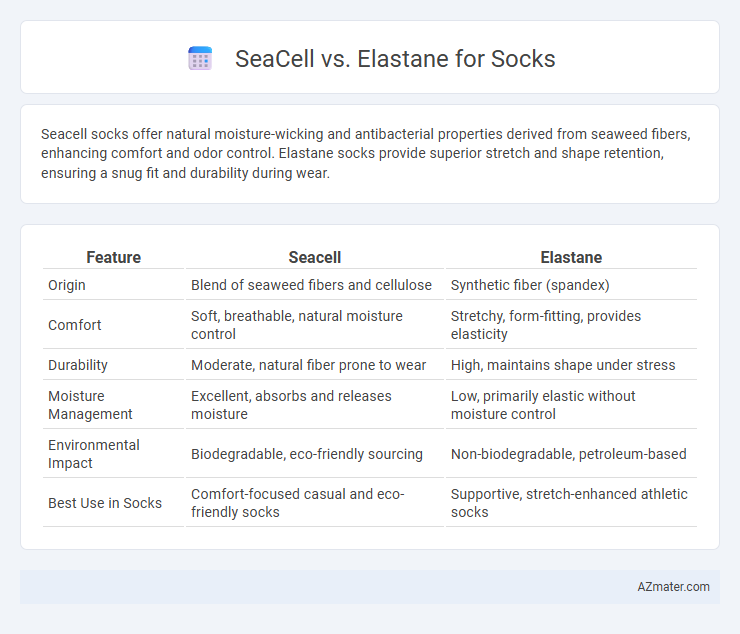Seacell socks offer natural moisture-wicking and antibacterial properties derived from seaweed fibers, enhancing comfort and odor control. Elastane socks provide superior stretch and shape retention, ensuring a snug fit and durability during wear.
Table of Comparison
| Feature | Seacell | Elastane |
|---|---|---|
| Origin | Blend of seaweed fibers and cellulose | Synthetic fiber (spandex) |
| Comfort | Soft, breathable, natural moisture control | Stretchy, form-fitting, provides elasticity |
| Durability | Moderate, natural fiber prone to wear | High, maintains shape under stress |
| Moisture Management | Excellent, absorbs and releases moisture | Low, primarily elastic without moisture control |
| Environmental Impact | Biodegradable, eco-friendly sourcing | Non-biodegradable, petroleum-based |
| Best Use in Socks | Comfort-focused casual and eco-friendly socks | Supportive, stretch-enhanced athletic socks |
Introduction to Seacell and Elastane
Seacell is an innovative fiber made from seaweed and cellulose, known for its eco-friendly properties and natural skin benefits, making it ideal for socks that promote comfort and sustainability. Elastane, commonly known as spandex or Lycra, offers exceptional stretch and recovery, providing socks with enhanced elasticity and a snug fit that maintains shape during wear. Combining Seacell's softness and biodegradability with Elastane's flexibility results in socks that deliver both comfort and durability.
What is Seacell? Key Properties and Benefits
Seacell is a sustainable fabric made from cellulose fibers infused with seaweed, known for its skin-soothing properties and natural antioxidant benefits. It offers moisture-wicking, breathability, and improved comfort, making it ideal for socks that promote healthy skin and reduce odor. The inclusion of seaweed components enhances softness, durability, and provides gentle antibacterial effects compared to synthetic fibers like elastane.
Understanding Elastane: Main Features
Elastane, also known as spandex or Lycra, is a synthetic fiber renowned for its exceptional elasticity, stretching up to five times its original length and recovering its shape quickly. This fiber enhances sock fit and comfort by providing superior flexibility, durability, and resistance to deformation during wear. Compared to Seacell, which is derived from seaweed and offers skin benefits, elastane primarily focuses on improving stretchability and maintaining the sock's shape under repeated use.
Sustainability: Seacell vs Elastane
Seacell fibers are derived from sustainably harvested seaweed, offering natural biodegradability and skin-friendly properties, making them an eco-conscious choice for socks. Elastane, a synthetic fiber produced from petrochemicals, lacks biodegradability and involves energy-intensive manufacturing processes that contribute to environmental pollution. Choosing Seacell socks supports reduced carbon footprint and waste, aligning with sustainable fashion practices.
Comfort and Softness Comparison
Seacell fibers, infused with algae extracts, provide exceptional moisture-wicking properties and a silky softness that enhances overall sock comfort by reducing skin irritation and promoting breathability. Elastane offers superior stretch and shape retention, ensuring socks fit snugly without sagging but may lack the natural softness found in Seacell. Combining Seacell with elastane in sock fabrics results in a balanced blend of plush softness and flexible comfort, ideal for all-day wear.
Breathability and Moisture Management
Seacell fibers, derived from seaweed and cellulose, offer excellent breathability and natural moisture management by wicking sweat away and allowing air circulation. Elastane, known for its stretch and recovery, enhances the fit of socks but has limited breathability and moisture-wicking properties on its own. Combining Seacell with Elastane in sock fabrics provides a balance of comfort, effective moisture control, and a snug, supportive fit.
Durability and Stretchability in Socks
Seacell socks offer moderate stretchability with natural fibers that enhance moisture absorption and comfort but may wear down faster compared to synthetic blends. Elastane socks provide superior stretchability and excellent durability, maintaining shape and resilience even after extensive wear and washing. Combining Seacell with Elastane can improve both durability and stretchability, delivering a balanced sock suited for active use.
Skin Sensitivity and Hypoallergenic Factors
Seacell fibers in socks offer superior skin sensitivity benefits due to their natural seaweed-based composition, which helps soothe irritation and promotes moisture retention. Elastane, while providing excellent stretch and durability, may cause allergic reactions in individuals with sensitive skin due to its synthetic nature. Seacell's hypoallergenic properties make it a preferred choice for those prone to skin allergies or sensitivities.
Performance in Everyday and Athletic Use
Seacell fibers in socks offer natural moisture-wicking, antibacterial properties, and enhanced skin comfort, making them ideal for reducing odor and irritation during everyday wear and light athletic activities. Elastane provides superior stretch and recovery, ensuring a snug fit that supports foot movement and prevents sagging in high-intensity sports or prolonged physical activities. Combining Seacell with elastane enhances sock durability, breathability, and performance by balancing comfort, flexibility, and moisture management in diverse use scenarios.
Which Material is Better for Socks?
Seacell fibers, derived from seaweed and cellulose, offer natural moisture-wicking, antibacterial properties, and enhanced skin comfort, making them ideal for sensitive skin in socks. Elastane, known for its exceptional stretch and shape retention, provides superior elasticity and durability to socks, ensuring a snug fit and long-lasting wear. For socks prioritizing comfort and skin benefits, Seacell is better, while Elastane excels in performance and fit, making the choice dependent on specific sock usage and wearer needs.

Infographic: Seacell vs Elastane for Sock
 azmater.com
azmater.com